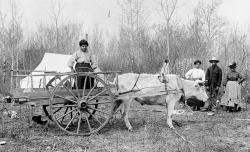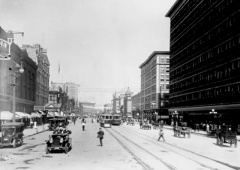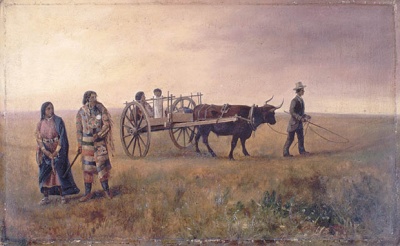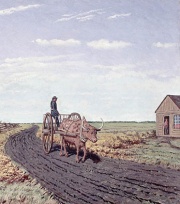Red River Cart
par Barkwell, Lawrence J.
The French Canadian traders and the Métis developed a wide network of trading routes across the Prairies using routes that were based on the Indian trails, which often followed buffalo trails. Crucial to the expansion of these trade routes, Métis craftsman of Red River settlements created a unique cart: the Red river cart. This cart is the best-known symbol of Métis culture. It is a symbol of the ingenuity, their nomadic way of life, and their trade skills that contributed in the development of the Prairies economy. Carts are still being made today by the Red River Metis Heritage Group at St. Norbert, Manitoba.
Article disponible en français : Charrette de la rivière Rouge
Characteristics of the Red River cart
The Metis were responsible for the development of the versatile Red River cart used to transport goods over the prairie terrain. In effect, the Metis commercialized the buffalo hunt with the invention of the Red River cart. Today, the Red River cart is one of the best-known symbols of Metis culture. The legacy of the Red River cart is still found in cities such as Winnipeg, Manitoba, which have very broad roadways. Portage Avenue in Winnipeg is wide because it is the original cart trail west, and carts used to travel from three to twenty carts abreast. The cart, drawn by either an ox or horse, was used to transport meat, buffalo hides, pemmican, trade items and personal belongings to and from the bison hunt and centres of trade in the United States.
As the West developed, settlements sprang up far away from the river transportation routes. Red River carts, which had been used for years by the Metis, became the chief mode of land transport to service these otherwise unreachable communities. As the need for larger and stronger carts increased, they became more refined. A much lighter spoked wheel gradually replaced the solid wheel. Made in a dish shape, these new wheels did not sink as far into the earth, making them easier to pull. The rawhide (green shaganappi) which bound the entire cart together became as tough as steel when dry and so strong, it would support a 450-kilogram load. One drawback to the carts was the loud noise the carts made because of the screeching of wood rubbing against wood as the wheels turned on unlubricated axles. Grease could not be used because this would pick up dust and dirt, which would wear out the hub and axle in no time.
The cart and Metis commercial operations
On November 15, 1801 at Pembina in the Minnesota Territory, Alexander Henry reports that his Metis employees are using carts with solid one-piece wheels. By September 20, 1802 they have:
"…a new sort of cart which facilitates transportation, hauling home meat, etc. The wheels are about four feet high and perfectly straight; the spokes are perpendicular, without the least bending outward, and only four to each wheel. These carts carry about five pieces (of 90 pounds), and are drawn by one horse (NOTE 1)."
By March of 1803 the men were building carts with more spokes and larger dished wheels of French-Canadien design. Cart making itself became a Metis industry and being a teamster replaced employment as a voyageur in the boat brigades. From the early 1800s to the advent of the railways in the west the Metis dominated the transportation industry. A number of Metis families in the Selkirk and Pembina districts began raising oxen to haul Red River carts. In the mid-1800s, the number of carts in use had increased as trade increased.
"[Metis] caravans or trains have annually increased in number, and now two hundred carts make the yearly pilgrimage across the prairies, six hundred and fifty miles, to St. Paul…They are laden with buffalo hides, pemmican, peltries, fur, embroidered leather coats, moccasins, saddles, &c. these they sell or exchange in St. Paul and return again to their secluded home… (NOTE 2)"
The size of Metis commercial operations was huge. Metis buffalo hunts were of colossal size. In 1865, Alexander Ross, a settler in Red River, reported in detail on an expedition that left the Red River Settlement on June 15, 1840. When the role was called at Pembina, 1,630 people were present with 1,210 Red River carts. In 1869, it was reported that at least 2,500 carts had passed through St. Cloud, MN carrying 600 tons of freight for the Hudson’s Bay Company (NOTE 3).
A versatile cart
The versatility of the cart was unmatched. With its high wheels, the cart could transverse the rutted prairie, be disassembled and floated as a raft across streams, or covered with waterproof hide and transformed into a boat. The wheels were simply removed and lashed to the bottom to form a raft. At day’s end, the cart could then be both covered with hide and used to provide shelter for the traveler, or when dozens were encircled, form a portable corral for livestock. In winter, the cart frame could be used as a sled pulled by a horse. The first Mace used in the Manitoba Legislature was constructed from part of a Red River Cart axle with the hub on the end.
The most experienced Metis freighters could handle ten carts, provided they were in a caravan. Normally, one man would handle six carts, with three being the minimum. In contrast, a teamster could only handle two wagons with ease.
George Dawson, a member of the 1872-1875 Boundary Commission, made notes on the difficulties met when traveling over the prairies in the vicinity of the Milk River:
"Red River Country Carts are little use in this part of the country to anybody but the Half-Breeds. When broken there is no hard wood to repair them and from the stony and rough character of the “roads” breaks are necessarily frequent. The sand and grit also rapidly wears away the axles unless iron bushes are used and then a poplar axle has to be substituted at risk of breakdown any moment. The extreme dryness of the air causes them to split and crack in all directions, especially the hubs, and when this happens the spokes work loose and nothing will save the wheel. By keeping the wheel always wet this may be avoided but water is scarce. With the Half-Breeds time is no object and cheapness is everything. They put on light loads and travel in large trains so that if one cart breaks down the load may be distributed and the fragments retained for future repairs(NOTE 4)."
By 1812 there were cart trails all across the west and the Metis were able to provide the provisions, without which, the Selkirk Settlers would have starved. Later, the major commercial trails were Pembina to Red River and Pembina to St. Paul, Minnesota, Red River to Fort Ellice, Red River to Carlton and Fort Carlton to Fort des Prairies (now Edmonton).
With the demise of the great buffalo herds and the arrival of the railway, the Metis were reduced to using their carts to pick buffalo bones. These were sold for processing sugar and making fertilizer and buttons.
The use of the cart today
The use of the carts slowly disappeared by the end of the 19th century with completion of the transcanadian railroad. Still, a group of people around the Red River Metis Heritage Group at St. Norbert, Manitoba are building the original carts. They use original tools and techniques to insure the authenticity of the Red River cart. This group made a cart trek from Pembina to Winnipeg for the opening of the North American Indigenous Games in 2002 and over 2004-2005, they made the trek from Winnipeg to Batoche Saskatchewan. In 2005 another group from Manitoba, Saskatchewan and Alberta made a trek from Batoche to Metis Crossing in Alberta to celebrate the opening of the Metis Crossing historic site. Carts can be seen on display at the St. Norbert Cultural Centre, the St. Boniface Museum and at the Manitoba Metis Federation.
Lawrence J. Barkwell
Coordinator of Metis Heritage and History Research
Louis Riel Institute
Winnipeg, Manitoba
NOTES
Note 1 : Elliot Coues (éd.), The Manuscript Journals of Alexander Henry and David Thompson, 1799-1814, Minneapolis, Ross & Haines Inc., 1965, p. 191.
Note 2 : Frank Blackwell Mayer, With Pen and Pencil on the Frontier in 1851 : The Diary and Sketches of Frank Blackwell Mayer, St. Paul, Minnesota Historical Society Press, 1986, p. 237-238.
Note 3 : Alexandria Post, 7 août 1869.
Note 4 : George M. Dawson, « General Diary and Note Book »,1874, p. 44. [On line] (Consulted on Novembre 20, 2007).
BIBLIOGRAPHY
Barkwell, Lawrence J., Leah M. Dorion and Darren R. Préfontaine. Metis Legacy: A Metis Historiography and Annotated Bibliography. Saskatoon: Gabriel Dumont Institute, Winnipeg: Pemmican Publications and Louis Riel Institute, 2001.
Barkwell, Lawrence J., Leah M. Dorion and Audreen Hourie. Metis Legacy, Volume Two: Michif Culture, Heritage and Folkways. Saskatoon: Gabriel Dumont Institute, Winnipeg: Pemmican Publications, 2007.
Brehaut, H.B. “The Red River Cart and Trails, The Fur Trade”, Historical and Scientific Society of Manitoba, Series III, No. 28, 1971/72: 5-35.
Coues, Elliot, ed., The Manuscript Journals of Alexander Henry and David Thompson, 1799-1814. Minneapolis, MN: Ross & Haines, Inc., 1965: 191.
Gilman, R.R., C. Gilman and D.H. Stultz. The Red River Trails, 1820-1870. St. Paul: Minnesota Historical Society Publications, 1979.
Knox, Olive. “Red River Cart”. The Beaver, Outfit 272, 1942: 39-43.
Mayer, Frank Blackwell. With Pen and Pencil on the Frontier in 1851: The Diary and Sketches of Frank Blackwell Mayer. St. Paul: Minnesota Historical Society Press, 1986.
Vrooman, Nicholas C.P. “The Metis Red River Cart,” in Journal of the West, Vol. 42, No. 2, Spring 2003: 8-20.
Additional DocumentsSome documents require an additional plugin to be consulted
Images
-
 [Buffalo bones gather
[Buffalo bones gather
ed from the Pra... -
 [Red River Ox Cart] D
[Red River Ox Cart] D
ate(s) [c 1880-... -
 Campement métis, une
Campement métis, une
charrette et un... -
 Charrette de la riviè
Charrette de la riviè
re Rouge, juin ...
-
 Fort Garry, rivière R
Fort Garry, rivière R
ouge Pièce (rel... -
 Habitations de colons
Habitations de colons
et charrette d... -
 Katrina Barkwell deva
Katrina Barkwell deva
nt une charrett... -
 Metis buffalo bone pi
Metis buffalo bone pi
ckers at Minnew...
-
 Portage Avenue Pièce
Portage Avenue Pièce
(reliée) Fait p... -
 Red River Carts from
Red River Carts from
Pembina camped ... -
 Une charrette de la r
Une charrette de la r
ivière Rouge à ...









